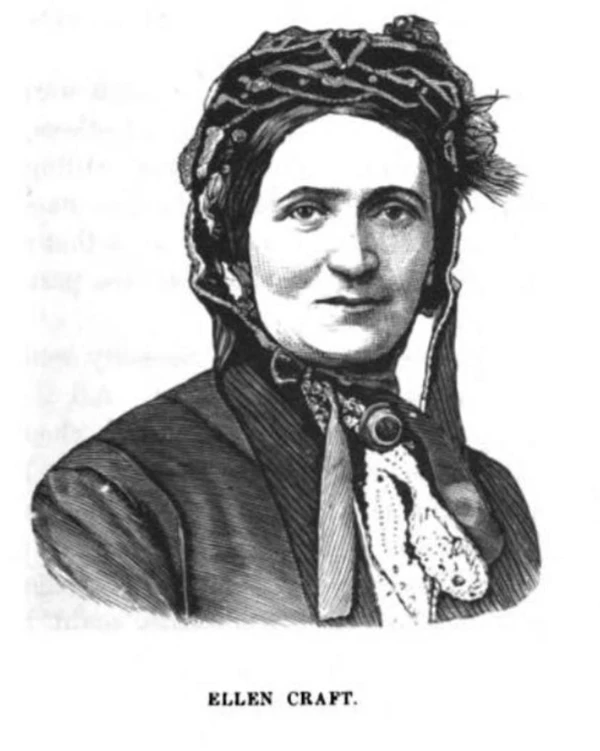Last updated: January 6, 2026
Person
Ellen Craft

Still's Underground Rail Road Records, William Still
Freedom seeker and abolitionist, Ellen Smith Craft notably disguised herself as a sickly, White gentleman in order to escape to freedom.
Born in 1826, Ellen Smith grew up as the daughter of a White slaveholder and an enslaved mother in Clinton, Georgia.1 Due to this parentage, she appeared "almost white." According to her husband William Craft,
in fact, [Ellen Smith] is so nearly [White] that the tyrannical old lady to whom she first belonged became so annoyed, at finding her frequently mistaken for a child of the family, that she gave her when eleven years of age to a daughter, as a wedding present.2
As a young enslaved woman, Ellen Smith met William Craft (also enslaved) in Macon, Georgia. While they wanted to obtain their freedom before marrying, Smith and Craft decided to "settle down in slavery."3 However, in 1848, William Craft came up with a plan that he believed could work. He told Ellen that if she disguised herself as an ill, young, White planter, and he played the role of the planter’s enslaved man, they could escape to freedom. Initially, Ellen Craft doubted the scheme, thinking she would not be able to successfully disguise herself for the extent of their escape. Yet, William Craft wrote, "the more she contemplated her helpless condition, the more anxious she was to escape from it."4
On December 21, 1848, Ellen and William Craft began their journey to freedom. They left Macon, Georgia early in the morning, catching a train to Savannah, Georgia. From there, the Crafts traveled up the East Coast, taking various steamers and trains. Throughout their journey, the Crafts faced several occasions when they feared discovery; however, Ellen Craft’s disguise as a sickly, young enslaver fooled the people who crossed their path. The Crafts successfully obtained their freedom when they arrived in Philadelphia on Christmas morning and soon continued north to Boston.5
Ellen and William Craft joined the Black community in Boston’s Beacon Hill, staying at Lewis and Harriet Hayden’s house.6 Over the next two years, Ellen Craft worked as a seamstress and, along with her husband, spoke at antislavery meetings in and around Boston. The passage of the Fugitive Slave Law in 1850 threatened the Crafts’ safety. In November of that year, two slave catchers successfully acquired a warrant to take the Crafts back into slavery. George and Susan Hillard first sheltered Ellen Craft from these men, and over the course of the next few days, Ellen Craft moved to several different houses throughout Boston in order to thwart the slave hunters.7
Once these men left Boston, the Crafts decided to leave for England. Before their departure, their friend, Reverend Theodore Parker, remarried them "according to the laws of a free State."8 In England, Ellen and William Craft started their family, having five children. They continued to advocate against slavery at various events, including at the Great Exhibition in London. Together, they also wrote Thousand Miles for Freedom; Or the Escape of William and Ellen Craft from Slavery, a thorough account of their escape from enslavement and their attempted capture in Boston.
While living in England, a rumor began to spread in the United States that Ellen Craft had asked an American man in London to return her to her enslaver. Disturbed by this rumor, Craft wrote a response, which the Massachusetts Spy published:
I write these few lines merely to say that the statement is entirely unfounded, for I never have had the slightest inclination whatever of returning to bondage... In fact, since my escape from slavery, I have got on much better in every respect, than I could have possibly anticipated. Though, had it been to the contrary, my feelings in regard to this would have been just the same, for I had much rather starve in England, a free woman, than be a slave to the best man that ever breathed on the American continent.9
A few years after the end of the US Civil War, Ellen Craft and her family returned to her home state of Georgia. With a desire to help newly emancipated men and women, Ellen and William Craft established the Woodville Co-operative Farm School in 1873. Although initially successful, the Crafts had to shut down the school due to economic issues in the 1880s. Ellen Craft and her husband decided to spend their last years of their lives with their daughter’s family in Charleston, South Carolina.10
Learn More...
"A Desperate Leap for Liberty": The Escape of William and Ellen Craft.
Footnotes
- Barbara McCaskill, Love, Liberation, and Escaping Slavery: William and Ellen Craft in Cultural Memory (Athens, Georgia: The University of Georgia Press, 2015), 18.
- William Craft, Running a Thousand Miles for Freedom; or, The Escape of William and Ellen Craft from Slavery (337 Strand, London: William Tweedie, 1860), https://archive.org/details/runningthousandm00craf/page/88/mode/2up?q=may, 2.
- Craft, Running a Thousand Miles for Freedom, 29.
- Craft, Running a Thousand Miles for Freedom, 30.
- For more information about the Craft’s escape to freedom, explore the story map: "A Desperate Leap for Liberty": The Escape of William and Ellen Craft.
- Kathryn Grover and Janine V. Da Silva, "Historic Resource Study: Boston African American National Historic Site," Boston African American National Historic Site, (2002) 132.
- William Still, Still's Underground Rail Road Records: With a Life of the Author. Narrating the Hardships, Hairbreadth Escapes and Death Struggles of the Slaves in Their Efforts for Freedom (United States: William Still, 1886), https://www.google.com/books/edition/Still_s_Underground_Rail_Road_Records/KD9LAAAAYAAJ?hl=en&gbpv=1&printsec=frontcover, 373-374.
- Still, Still's Underground Rail Road Records, 371.
- “Letter from Ellen Craft,” Massachusetts Spy (Worcester, Massachusetts), December 29, 1852.
- Barbara McCaskill, "William and Ellen Craft (1824-1900; 1826-1891)," New Georgia Encyclopedia, July 16, 2020, accessed 19 August 2020, https://www.georgiaencyclopedia.org/articles/history-archaeology/william-and-ellen-craft-1824-1900-1826-1891.
